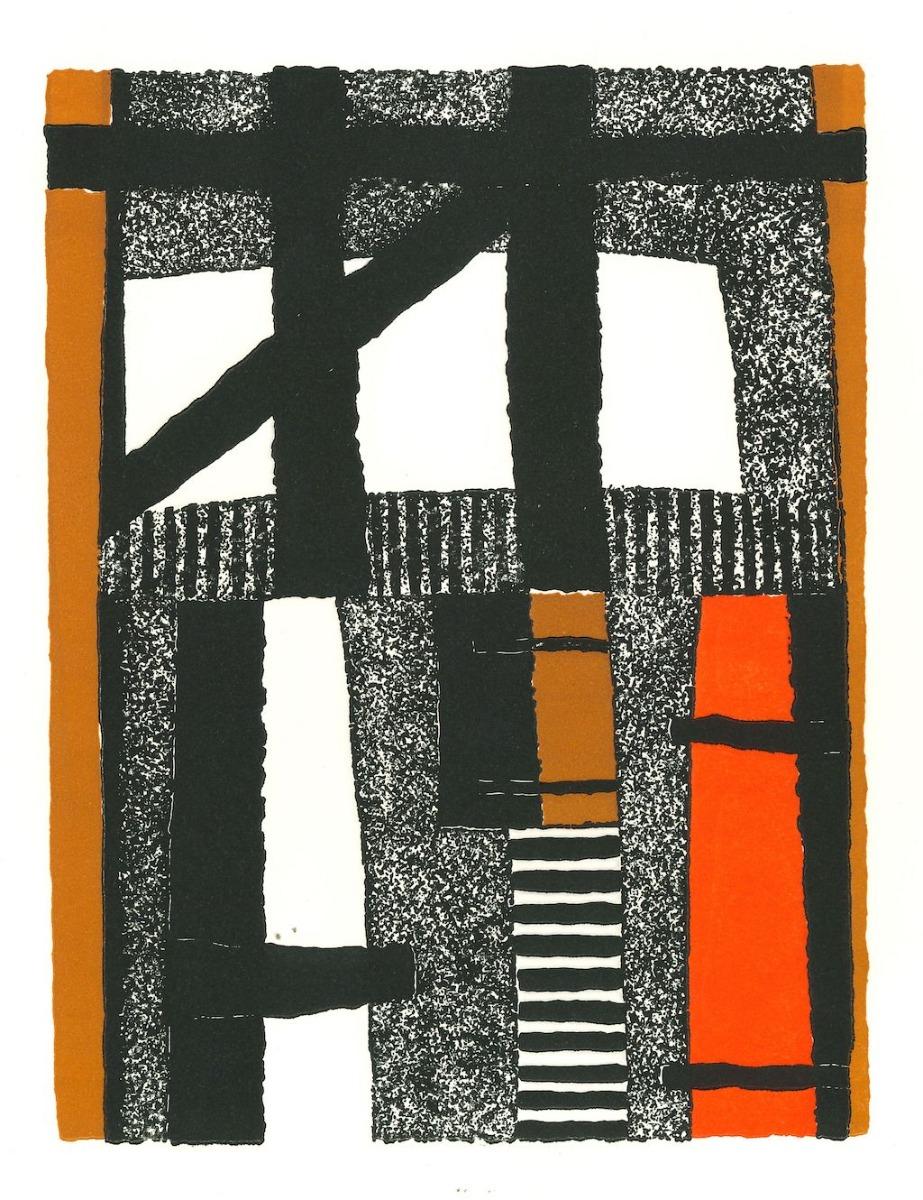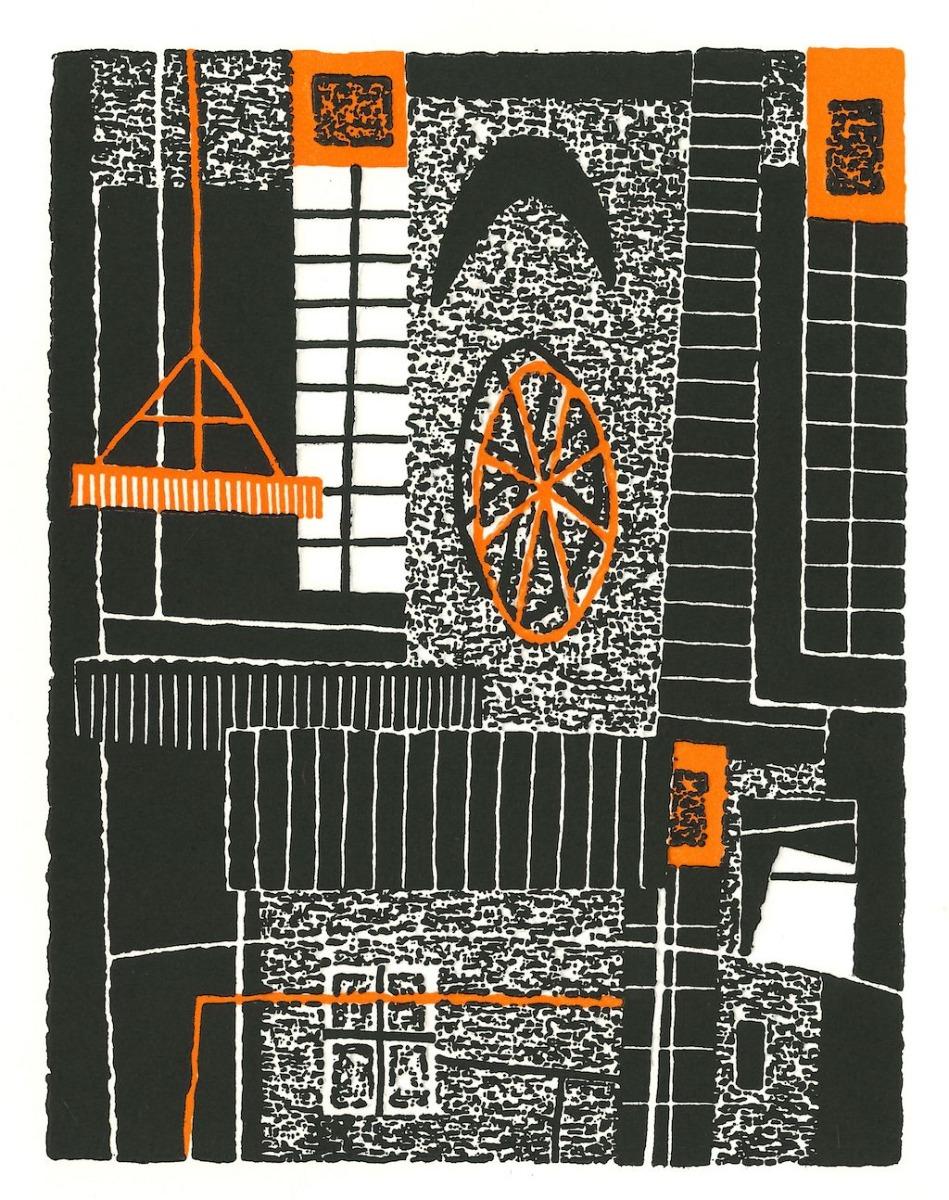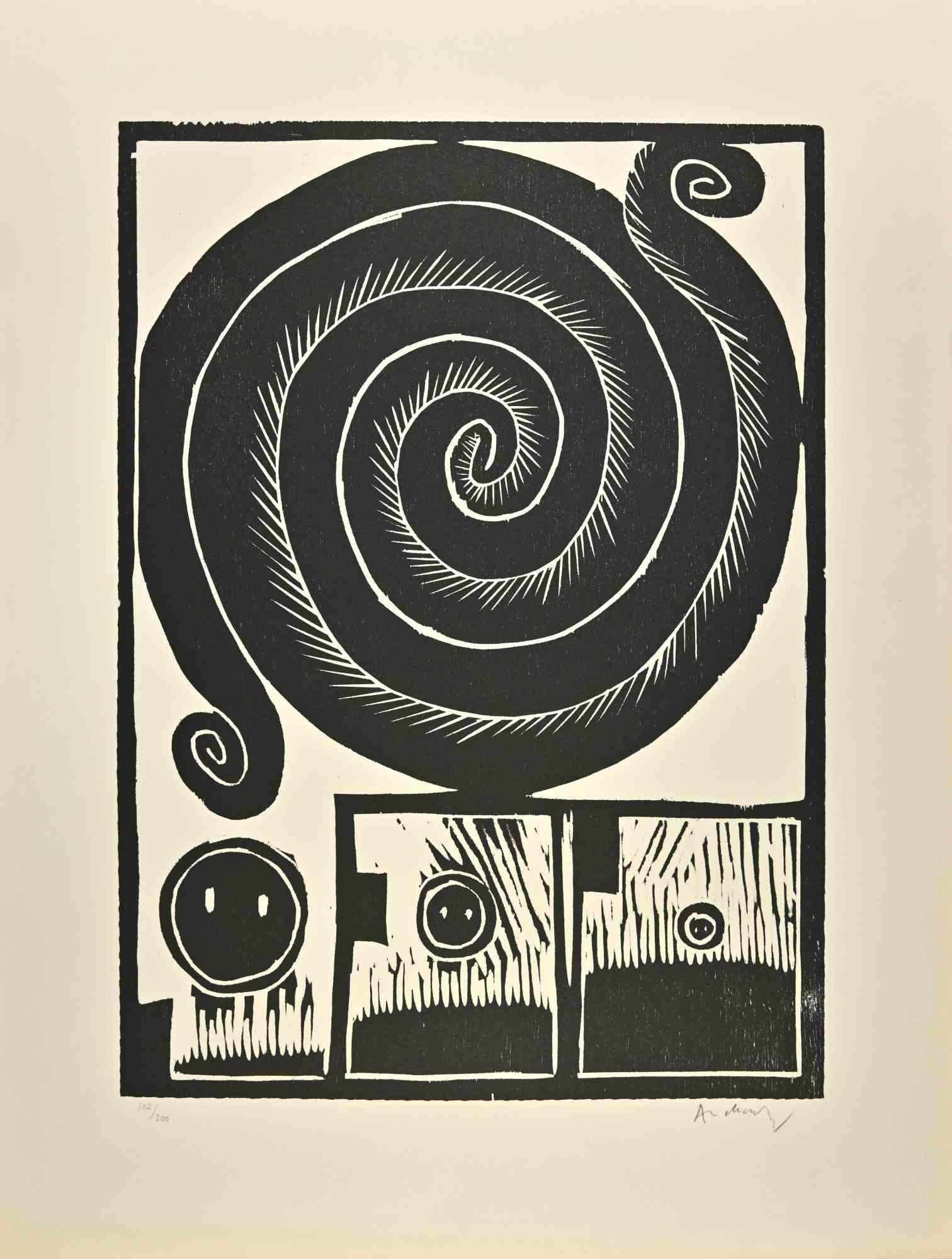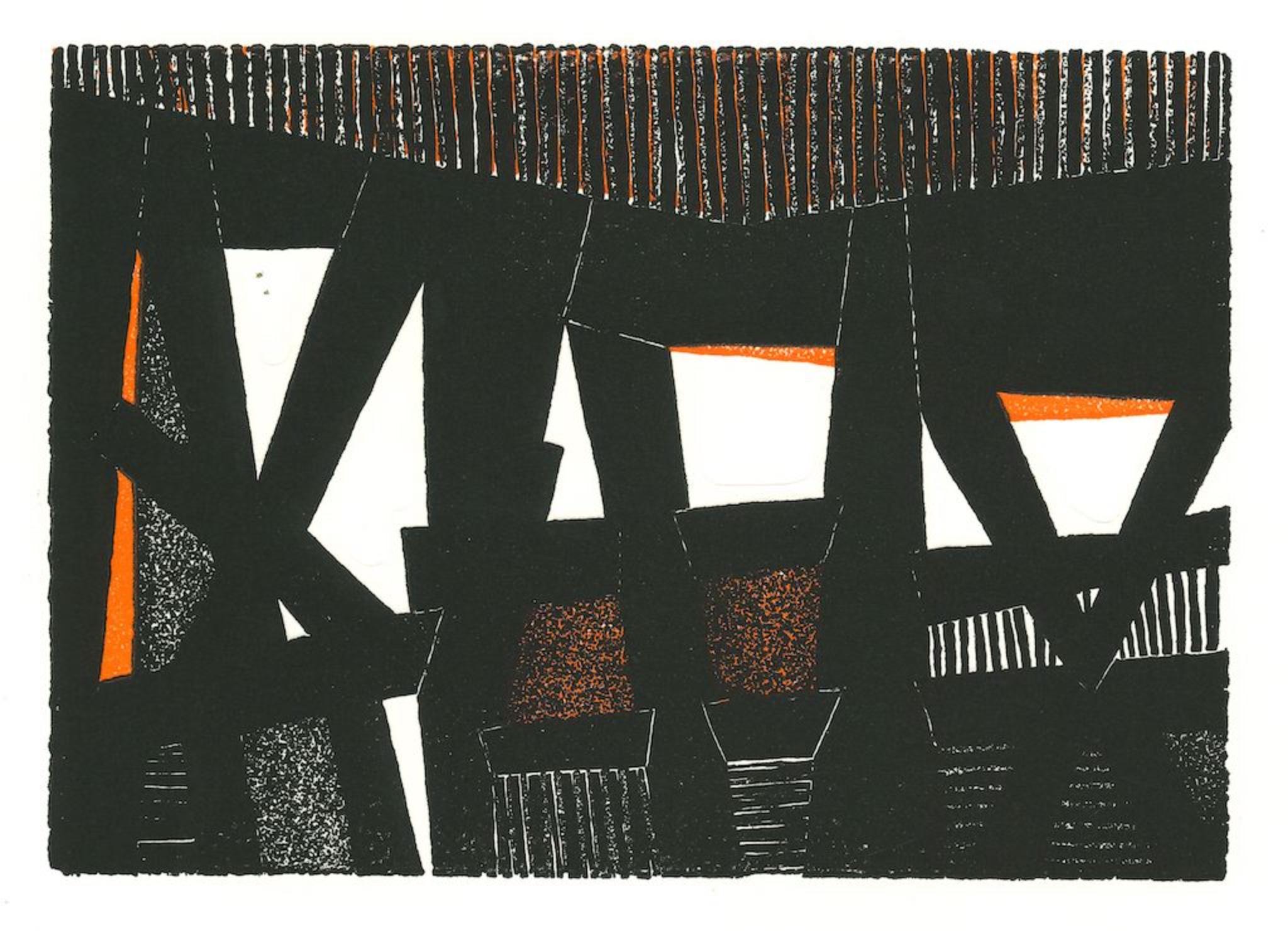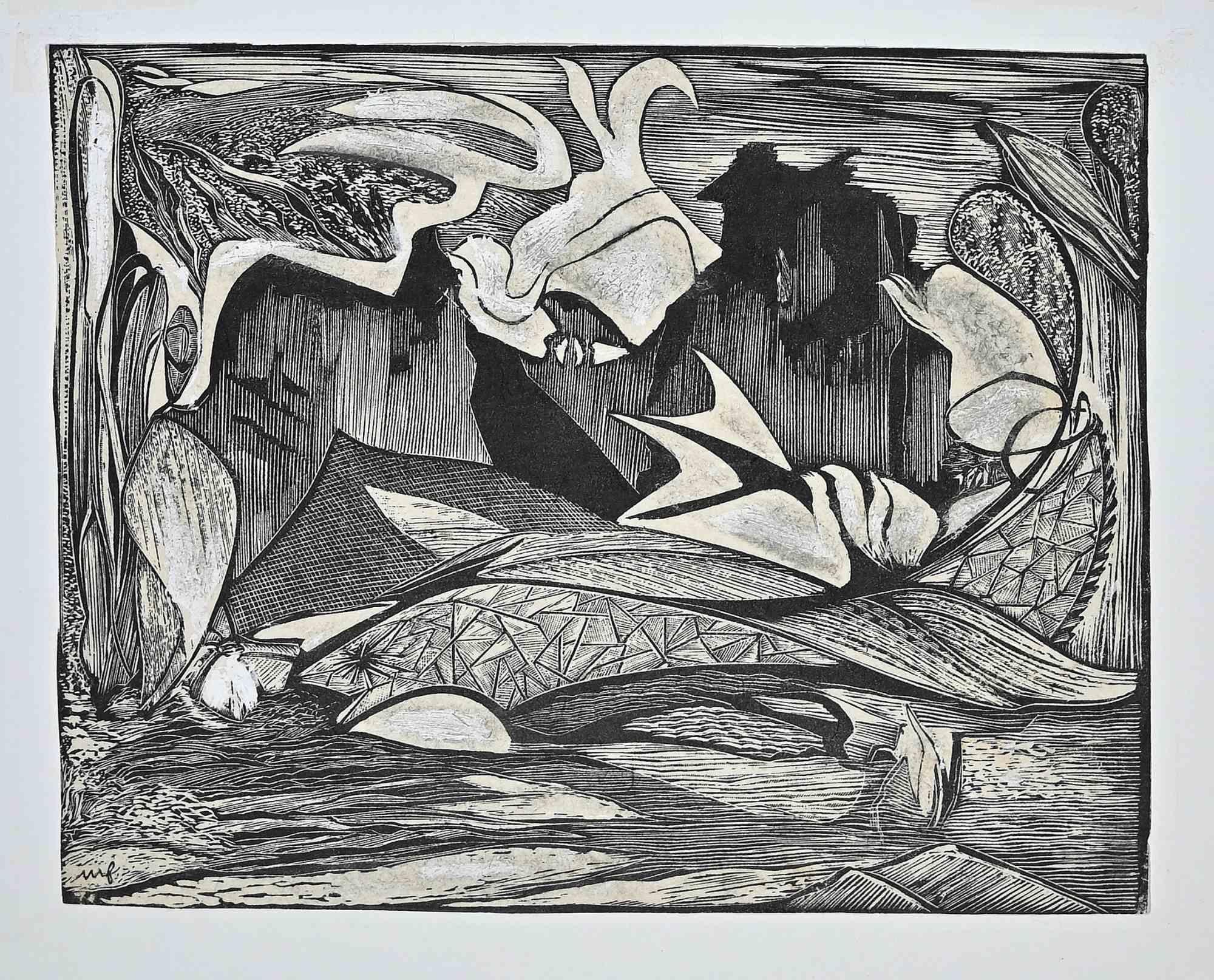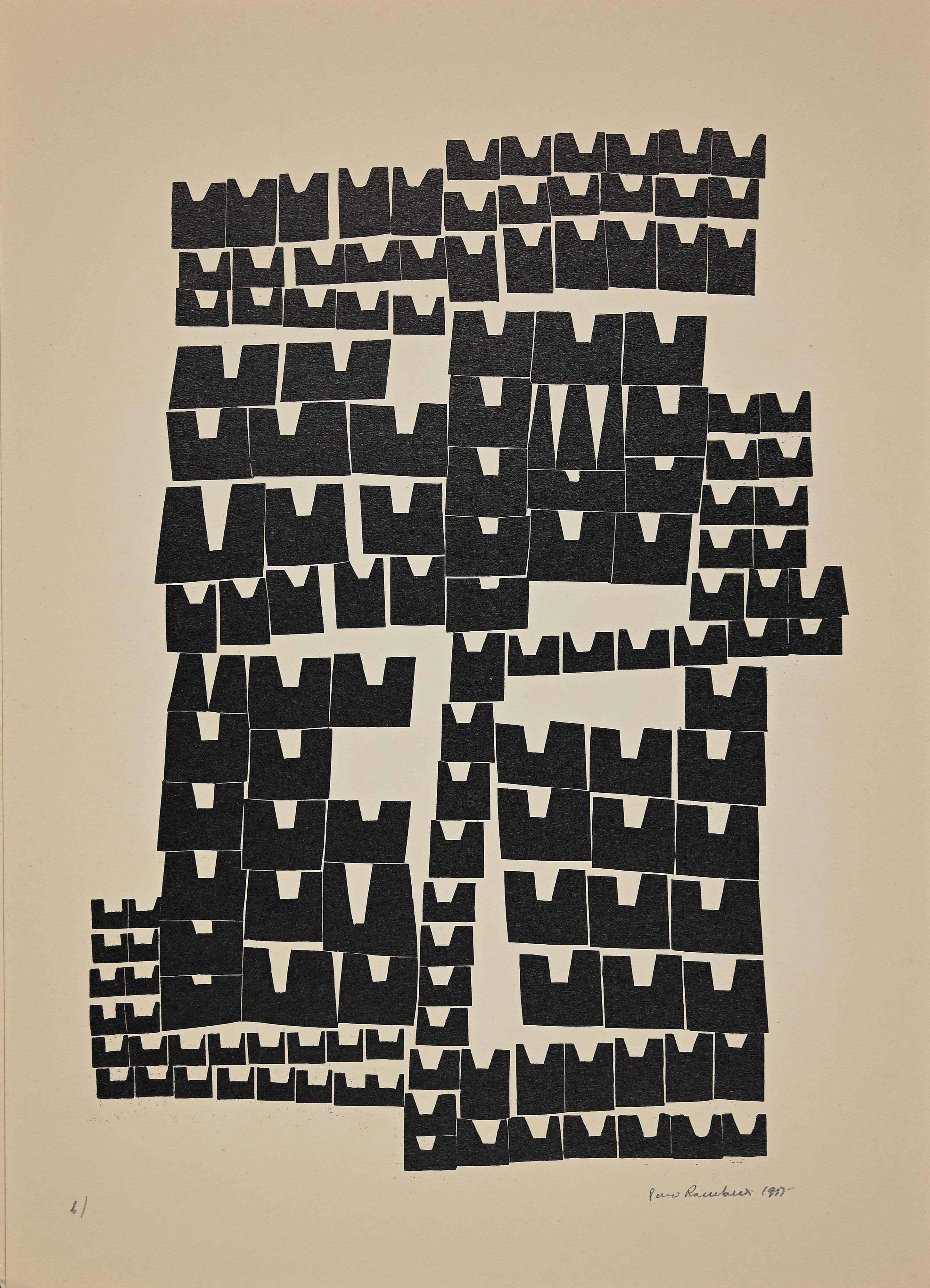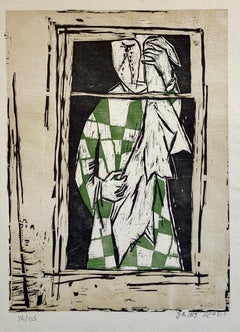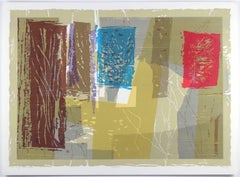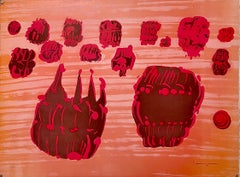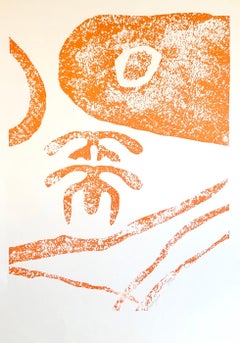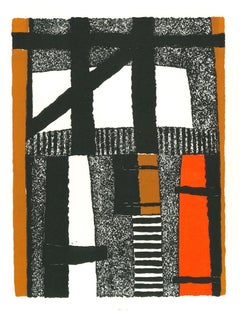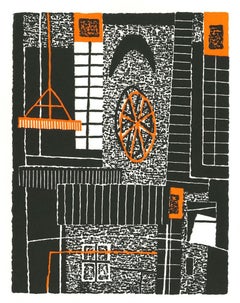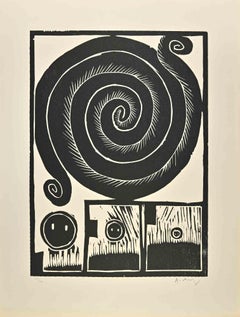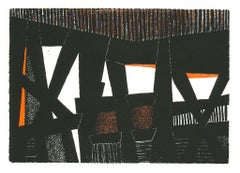Items Similar to 1966 Woodcut "Fleet" Modernist Print
Want more images or videos?
Request additional images or videos from the seller
1 of 6
Roger Martin1966 Woodcut "Fleet" Modernist Print1966
1966
$750
£566
€647.99
CA$1,057.75
A$1,161.28
CHF 605.84
MX$14,053.06
NOK 7,593.27
SEK 7,154.85
DKK 4,837.07
About the Item
Genre: Modern
Subject: Landscape
Medium: Print, Woodcut
Surface: Paper
Dimensions w/Frame: 31" x 15 1/2"
Roger was born in the Addison Gilbert Hospital in Gloucester, MA, the son of Capt. Roger Martin and Ellie Emilia Oker, in 1925. His father was born in Rockport, of Portuguese heritage, and his mother was born in Finland. He graduated from Rockport Highschool in 1942. While in high school Roger prepared lobsters for tourists at the Roy Moore Lobster Company on Bearskin Neck and sang and played harmonica with Tony Torissi’s hillbilly band.
Roger enlisted in the U.S. Coast Guard in 1942 and mustered out in 1946, ending his military career as a member of the USCG canine corps only two weeks from going to the Pacific with a Marine detachment. After having lived on both coasts (Manhattan and Los Angeles) he returned to his home town from the West Coast, vowing to never leave again, and he hasn’t. When he returned to Cape Ann he entered the School of the Museum of Fine Arts in Boston where he majored in book design and illustration, graduating with honors.
He illustrated a number of textbooks for D.C. Heath, Beacon Press, and other Boston publishers, as well as provided illustrations for the New York Sunday Times, the New Yorker magazine, the Atlantic Monthly magazine, and a book for the United Church of Christ.
Roger also designed, carved and gold-leafed pipe shades for a number of C. B. Fisk pipe organs, builders of tracker action pipe organs, including those at Harvard and Stanford Universities.
He began his teaching career in Rockport, teaching elementary grade art, following that with four years teaching at the New England School of Art in Boston. Roger became a founding faculty member of the Montserrat College of Art in Beverly, MA, where he taught for twenty years, retiring to make paintings. He was also elected Rockport’s Poet Laureate in the 1990s and in addition wrote and published three books about Rockport.
Roger Martin has exhibited his work throughout New England and beyond. He has shown his work in Portland, ME; New York City; Andover’s Addison Gallery; the Boston ICA; galleries on Newbury Street in Boston; the Rockport Art Association; the Cape Ann Historical Museum (where he is part of the permanent collection); and many others. His work is represented in many private collections, including those of John Updike, Bernard and Ninon Chaet, and Ralph Coburn.
- Creator:Roger Martin (1925 - 2015, American)
- Creation Year:1966
- Dimensions:Height: 31.5 in (80.01 cm)Width: 15.5 in (39.37 cm)
- Medium:
- Movement & Style:
- Period:
- Condition:frame has some wear. print has some age toning.
- Gallery Location:Surfside, FL
- Reference Number:1stDibs: LU38211751762
About the Seller
4.9
Platinum Seller
Premium sellers with a 4.7+ rating and 24-hour response times
Established in 1995
1stDibs seller since 2014
1,810 sales on 1stDibs
Typical response time: 1 hour
- ShippingRetrieving quote...Shipping from: Surfside, FL
- Return Policy
Authenticity Guarantee
In the unlikely event there’s an issue with an item’s authenticity, contact us within 1 year for a full refund. DetailsMoney-Back Guarantee
If your item is not as described, is damaged in transit, or does not arrive, contact us within 7 days for a full refund. Details24-Hour Cancellation
You have a 24-hour grace period in which to reconsider your purchase, with no questions asked.Vetted Professional Sellers
Our world-class sellers must adhere to strict standards for service and quality, maintaining the integrity of our listings.Price-Match Guarantee
If you find that a seller listed the same item for a lower price elsewhere, we’ll match it.Trusted Global Delivery
Our best-in-class carrier network provides specialized shipping options worldwide, including custom delivery.More From This Seller
View All1959 Israeli Yosl Bergner Modernist Color Woodcut Woodblock Print
By Yosl Bergner
Located in Surfside, FL
Abstract Composition, 1959 Silkscreen Lithograph "Phoenix".
This was from a portfolio which included works by Yosl Bergner, Menashe Kadishman, Yosef Zaritsky, Aharon Kahana, Jacob Wexler...
Category
1950s Modern Figurative Prints
Materials
Lithograph, Screen
Court of Solitude Chinese American Modernist Abstract Color Woodcut
By Seong Moy
Located in Surfside, FL
Printed on French Arches paper. Hand signed and numbered 4/35 Artist's Proof
Seong Moy was born in Canton on April 12, 1921 but he immigrated to the United States in 1931, settling...
Category
1970s Abstract Abstract Prints
Materials
Woodcut
Pietro Consagra Italian Mod Abstract Expressionist Forma Brutalist Lithograph
By Pietro Consagra
Located in Surfside, FL
Pietro Consagra (Italian, 1920-2005).
Hand signed in pencil and numbered limited edition color lithograph on Magnani paper.
Embossed stamp with limited edition numbers in pencil to lower left, and having artist pencil signature to lower right.
(from a limited edition of 80 with 15 artist's proofs)
Published by Stamperia 2RC, Rome Italy and Marlborough Gallery, Rome, Italy.
Abstract Modernist work in colors, produced in the style of the Forma art movement of Postwar Italy, of which the artist was a prominent member.
Pietro Consagra (1920 – 2005) was an Italian Post war artist working in painting, printmaking and sculpture. In 1947 he was among the founding members of the Forma 1 group of artists, proponents of structured abstraction.
Consagra was born on 6 October 1920 in Mazara del Vallo, in the province of Trapani in south-western Sicily, to Luigi Consagra and Maria Lentini. From 1931 he enrolled in a trade school for sailors, studying first to become a mechanic, and later to become a captain. In 1938 he moved to Palermo, where he enrolled in the liceo artistico; despite an attack of tuberculosis, he graduated in 1941, and in the same year signed up at the Accademia di Belle Arti, where he studied sculpture under Archimede Campini. After the Invasion of Sicily and the Allied occupation of Palermo in 1943, Consagra found work as a caricaturist for the American Red Cross club of the city; he also joined the Italian Communist Party. Early in 1944, armed with a letter of introduction from an American officer, he travelled to Rome. There he came into contact with the Sicilian artist Concetto Maugeri, and through him with Renato Guttuso, who was also Sicilian and who introduced him to the intellectual life of the city and to other postwar artists such as Leoncillo Leonardi, Mario Mafai and Giulio Turcato. Consagra signed up at the Accademia di Belle Arti di Roma in September 1944 and studied sculpture there under Michele Guerrisi, but left before completing his diploma.
In 1947, with Carla Accardi, Ugo Attardi, Piero Dorazio, Mino Guerrini, Achille Perilli, Antonio Sanfilippo and Giulio Turcato, Consagra started the artist's group Forma 1, which advocated both Marxism and structured abstraction.
Steadily Consagra's work began to find an audience. Working primarily in metal, and later in marble and wood, his thin, roughly carved reliefs, began to be collected by Peggy Guggenheim and other important patrons of the arts. He showed at the Venice Biennale eleven times between 1950 and 1993, and in 1960 won the sculpture prize at the exhibition. During the 1960s he was associated with the Continuità group, an offshoot of Forma I, and in 1967 taught at the School of Arts in Minneapolis. Large commissions allowed him to begin working on a more monumental scale, and works of his were installed in the courtyard of the Foreign Ministry in Rome and in the European Parliament, Strasbourg. His work is found in the collections of The Tate Gallery, London, in Museo Cantonale d'Arte of Lugano and the Museum of Modern Art, Paris, and the National Gallery of Art in Washington, D.C..
Consagra returned to Sicily where he sculpted a number of significant works during the 1980s. With Senator Ludovico Corrao, he helped created an open-air museum in the new town of Gibellina, after the older town had been destroyed in the earthquake of 1968. Consagra designed the gates to the town's entrance, the building named "Meeting" and the gates to the cemetery, where he was later buried.
In 1952 Consagra published La necessità della scultura ("the need for sculpture"), a response to the essay La scultura lingua morta ("sculpture, a dead language"), published in 1945 by Arturo Martini. Other works include L'agguato c'è ("the snare exists", 1960), and La città frontale ("the frontal city", 1969). His autobiography, Vita Mia, was published by Feltrinelli in 1980. In 1989 a substantial retrospective exhibition of work by Consagra was shown at the Galleria Nazionale d'Arte Moderna in Rome; in 1993 a permanent exhibition of his work was installed there. In 1991 his work was shown in the Hermitage Museum in St. Petersburg. In 2002 the Galerie der Stadt Stuttgart opened a permanent exhibition of his work. He was one of ten artists invited by Giovanni Carandente, along with David Smith, Alexander Calder, Arnaldo Pomodoro, Lynn Chadwick, and Beverly Pepper, to fabricate works in Italsider factories in Italy for an outdoor exhibition, "Sculture nella città", held in Spoleto during the summer of 1962. He was included in the The 1962 International Prize for Sculpture the jury included Argan, Romero Brest and James Johnson Sweeney the former director of the Solomon R. Guggenheim Museum in New York. The participants included Louise Nevelson and John Chamberlain for the United States; Lygia Clark for Brazil; Pietro Consagra, Lucio Fontana, Nino Franchina, and Gió Pomodoro for Italy; Pablo Serrano for Spain; and Eduardo Paolozzi, William Turnbull, and Kenneth Armitage for England. Gyula Kosice, Noemí Gerstein, Julio Gero, Naum Knop...
Category
1960s Abstract Expressionist Abstract Prints
Materials
Lithograph
Motif. Abstract, African American Artist Viola Leak Woodcut Silkscreen Print
By Viola Burley Leak
Located in Surfside, FL
Motif (Abstract) in orange abstract.
From the small edition of 10. from 1982. I am not sure if this is a woodcut or woodblock print or a silkscreen screenprint or some combination.
Viola Burley Leak, American (1944 - )
Viola Leak was born in Nashville, Tennessee, she received a B.A. in Art from Fisk University, a B.F.A. in Fashion Design from Pratt Institute, Brooklyn, an M.A. from Hunter College, NY and an M.F.A. in Media from Howard University, Washington, DC. Leak was an art consultant for both the New York State Board of Education and the Metropolitan Museum of Art's Print Department, in addition to working for the Experimental Gallery of Art at the Smithsonian Institute. Her mixed media work often references religious motifs and those of her African-American experience and heritage.
She is a multimedia artist, her works include printmaking, textile designing, soft sculpture, appliqué tapestries, doll making, and multi-media.
Viola has studied with many renowned artists such as Aaron Douglas, Romare Bearden, Robert Blackburn, and Charles White. Her works can be found in the collections of World Federation of United Nations, New York State Office Building, Manufacturers of Hanover Trust Company, Atlanta Life Insurance Company and many more organizations.
Viola's exhibition experience is extensive - more than 100 showings over a decade, national and international. Her quilts exude a miraculous and magical presence. They have traveled in two international shows and three national quilt projects in the past three years.
A proud moment for her was being featured in the December 20, 2000 of the Smithsonian magazine; the article praised her mural "Afro Dance Scan" as one of the outstanding artworks in the "When the Spirit Moves: African American Dance...
Category
1980s Contemporary Figurative Prints
Materials
Screen, Woodcut
Spanish Artist Santi Moix Aquatint Etching Ed 2/3 Surrealist Abstract Symbols
By Santi Moix
Located in Surfside, FL
Moix, Santi (Spanish, b. 1960), Figural Abstraction, hybrid print with etching and aquatint, 23.5 x 16.75 inches, pencil signed and numbered 2/3.
Santi Moix (Barcelona, 1960) lives ...
Category
20th Century Surrealist Abstract Prints
Materials
Etching, Aquatint
French Avant Garde Bold Abstract Geometric Aquatint Etching Op Art Kinetic
By Jean Deyrolle
Located in Surfside, FL
Original etching, aquaforte, aquatint engraving. Hand pencil signed and numbered. Published by Editions Denise René, Paris.
Number: 10 from the folio edition of 120 which were on ...
Category
1960s Abstract Geometric Abstract Prints
Materials
Etching, Aquatint
You May Also Like
Composition - Woodcut by Luigi Spacal - 1970s
Located in Roma, IT
Composition is a contemporary artwork realized by Luigi Spacal (Trieste, 1907 - Trieste, 2000) in the 1970s.
Original Colored woodcut print on cardboard. Image Dimensions: 18 x 14 cm
Good conditions.
Lojze Spacal...
Category
1970s Abstract Abstract Prints
Materials
Woodcut
Composition - Original Woodcut by Luigi Spacal - 1970s
Located in Roma, IT
Composition is an original contemporary artwork realized by Luigi Spacal (Trieste, 1907 - Trieste, 2000) in the 1970s.
Original Colored woodcut on cardboard.
Good conditions. Image Dimensions: 14 x 12.5 cm
Lojze Spacal, also known as Luigi Spacal, was born on the Trieste Karst, at the time of the Austro-Hungarian Empire, from a family of Slovenian nationality.In 1930 he was arrested on charges of anti-fascism and confined for some time to Accettura, in Basilicata. Here he discovered his artistic vocation. In 1934 he graduated in Venice. He began to exhibit his first works in 1937. In 1942 he was again sent to confinement, this time in Abruzzo and, later, assigned to a special working battalion in Forte dei Marmi. Nevertheless, he managed to continue to exhibit his works so much that, in 1944, he set up his first solo show. In 1948 he participated for the first time in the Venice biennial. In 1958 he won the International Grand Prix "for a draftsman and engraver" at the Venice Biennale. In 1959 he received the 2nd prize at the International Biennial of Graphic Art in Ljubljana. In 1974 he was awarded the Prešeren prize, the highest Slovenian artistic recognition, and the “San Giusto d'Oro” in 1977. In 1998 a museum was dedicated to him in the castle of San Daniele...
Category
1970s Abstract Abstract Prints
Materials
Woodcut
Untitled - Woodcut by Pierre Alechinsky - 1970
By Pierre Alechinsky
Located in Roma, IT
Untitled is an Woodcut print realized by Pierre Alechinsky in 1970.
Hand signed on the right margin and numbered on the left corner es. 102/300
The artwork is depicted through stro...
Category
1970s Abstract Figurative Prints
Materials
Woodcut
Composition - Woodcut by Luigi Spacal - 1970s
Located in Roma, IT
Composition is a contemporary artwork realized by Luigi Spacal (Trieste, 1907 - Trieste, 2000) in the 1970s.
Original Colored woodcut on cardboard. Image Dimensions: 22 x 16.5 cm
Good conditions.
Lojze Spacal, also known as Luigi Spacal, was born on the Trieste Karst, at the time of the Austro-Hungarian Empire, from a family of Slovenian nationality.In 1930 he was arrested on charges of anti-fascism and confined for some time to Accettura, in Basilicata. Here he discovered his artistic vocation. In 1934 he graduated in Venice. He began to exhibit his first works in 1937. In 1942 he was again sent to confinement, this time in Abruzzo and, later, assigned to a special working battalion in Forte dei Marmi. Nevertheless, he managed to continue to exhibit his works so much that, in 1944, he set up his first solo show. In 1948 he participated for the first time in the Venice biennial. In 1958 he won the International Grand Prix "for a draftsman and engraver" at the Venice Biennale. In 1959 he received the 2nd prize at the International Biennial of Graphic Art in Ljubljana. In 1974 he was awarded the Prešeren prize, the highest Slovenian artistic recognition, and the “San Giusto d'Oro” in 1977. In 1998 a museum was dedicated to him in the castle of San Daniele...
Category
1970s Abstract Abstract Prints
Materials
Woodcut
Composition - Original Woodcut Print By Madeleine Flaschner - Late-20th Century
Located in Roma, IT
Composition is an Original Woodcut realized by Madeleine Flaschner (1933-....).
The artwork is an experience greatly enhanced by the artist.
Mono...
Category
19th Century Modern Figurative Prints
Materials
Woodcut
Viaggio sul fiume - Woodcut Portfolio by Piero Rambaudi - 1955
Located in Roma, IT
Portfolio of 6 hand signed black and white Woodcuts. Introduction and biography by Giusta Nicco Fasola. Edition of 150 prints.
Very good conditions.
Piero Rambaudi (Torino, 1906- T...
Category
1950s Abstract Abstract Prints
Materials
Woodcut
More Ways To Browse
Musterring Vintage
Waterloo Anthonie
Axis Mundi
Banksy Walled Off Hotel
Banksy Walled Off
Cartier Poster
Dali Butterfly Suite
David Hockney Red
David Roberts Petra
Earlom Mezzotint
Ernest Roth Etching
Galerie 65 Cannes
Gloucester Etching
Hawaiian Prints Webber
Hoshi Joichi
J Torrents Llado
Jean Solombre
Landscape Etchings Set
